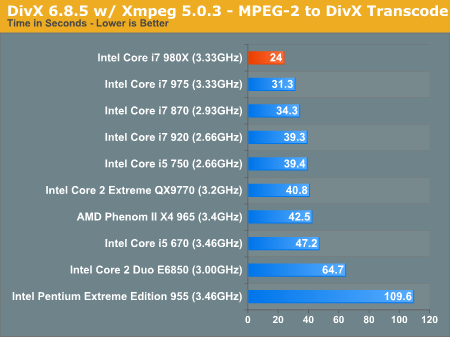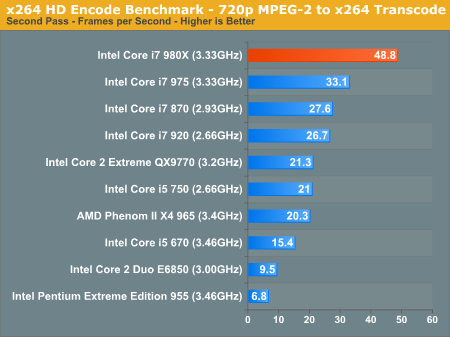The Core i7 980X Review: Intel's First 6-Core Desktop CPU
by Anand Lal Shimpi on March 11, 2010 12:00 AM EST- Posted in
- CPUs
DivX 8.5.3 with Xmpeg 5.0.3
Our DivX test is the same DivX / XMpeg 5.03 test we've run for the past few years now, the 1080p source file is encoded using the unconstrained DivX profile, quality/performance is set balanced at 5 and enhanced multithreading is enabled:

Our DivX and WME tests are getting long in the tooth. Most serious encoding is done using H.264 now, but I included these results to show that even in lighter workloads the 980X can still manage to pull ahead of the 975. The 980X is 30% faster in our DivX encode test, and it completes the encode in less than a quarter of the time of the old Pentium EE 955.
x264 HD Video Encoding Performance
Graysky's x264 HD test uses the publicly available x264 codec (open source alternative to H.264) to encode a 4Mbps 720p MPEG-2 source. The focus here is on quality rather than speed, thus the benchmark uses a 2-pass encode and reports the average frame rate in each pass.

To see what 6 cores and 12 threads can do we needn't look any further than the second (encoding) pass of our x264 benchmark:

The Core i7 980X is nearly 50% faster than the Core i7 975, 76% faster than the i7 870 and over twice the speed of the QX9770. This is a greater performance jump than we've seen from any single architectural shift. If you are serious about video encoding, you want Gulftown.
Windows Media Encoder 9 x64 Advanced Profile
In order to be codec agnostic we've got a Windows Media Encoder benchmark looking at the same sort of thing we've been doing in the DivX and x264 tests, but using WME instead.

Our Windows Media Encoder 9 test is the lightest of our video encoding tests. Without stressing the additional cores, the 980X performs no different from the 975.










102 Comments
View All Comments
softdrinkviking - Thursday, March 11, 2010 - link
it's a 2-p4 mcm at at a lower node with a lotof improvements over the older p4 manufacturing processes.
if i absolutely had to have netburst, that's what i would want.
i think it's really nice that Anand includes it in the comparison, because it gives a sense of history to the article, and it shows how much faster CPUs have gotten in such a short time.
JonnyDough - Thursday, March 11, 2010 - link
Yep. It might be based on P4, but you can't really considered a P4. It was based on two cedar mill cores rather than smithfield with double the cache and a 200mhz bus speed jump.Dadofamunky - Thursday, March 11, 2010 - link
And exactly the same NetBurst architecture otherwise. And I'm sorry, but seeing that POS coming up with 40% against Gulftown signifies either one of two things: Gulftown isn't that much faster; or, the SysMark software distorts the relative performance results. That isn't a realistic portrayal of 'history.' SysMark 2007 badly needs an update. It isn't a realistic tool for the 4-to-6-core world.danielkza - Thursday, March 11, 2010 - link
Weird, other sites managed to squeeze up to 4.4GHz of the 980X on air, and 4.7GHz on WC. I thought initially of different stability requirements from both parts, but bit-tech ran all their benchmarks at both 4400MHz and 4720MHz. Maybe Anand's DX58 isn't holding up so well after all.http://www.bit-tech.net/hardware/cpus/2010/03/11/i...">http://www.bit-tech.net/hardware/cpus/2...-core-i7...
DanNeely - Thursday, March 11, 2010 - link
Anand only used a stock cooler to test. The intel coolers never have much head room in them. Luck of the draw in both mobo and CPU might be a factor but so is bit-tech's better cooling.chrisfam - Thursday, March 11, 2010 - link
Tomshardware got a 4.13 Ghz overclock with 1.4v and with Enhanced SpeedStep and Turbo Boost enabled. Neoseeker got a 4.16 Ghz overclock with just 1.35v. And both of these were with the stock heat sink.Anand Lal Shimpi - Thursday, March 11, 2010 - link
I've been working on a follow up to go deeper into our overclocked numbers. A motherboard swap later and a little bit of work appears to be paying off...I'm over 4.1GHz already :-)Update soon!
Take care,
Anand
chrisfam - Thursday, March 11, 2010 - link
Updated overclock (4.13 Ghz, 1.359V) is much better. Thanks for the update.Rajinder Gill - Thursday, March 11, 2010 - link
That's right, 3.7-3.8GHz is the full load limit of Intel's stock cooler with these beasts. We ran out of time to really push, but I'm sure we'll find out what these chips can do in due course.regards
Raja
strikeback03 - Thursday, March 11, 2010 - link
Is the new tower cooler an improvement in any way over the old one? Is it quieter, as it doesn't seem to offer more OC headroom.Also, how does the CPU power consumption increase by 130W at load over idle, while system consumption only goes up 90W?